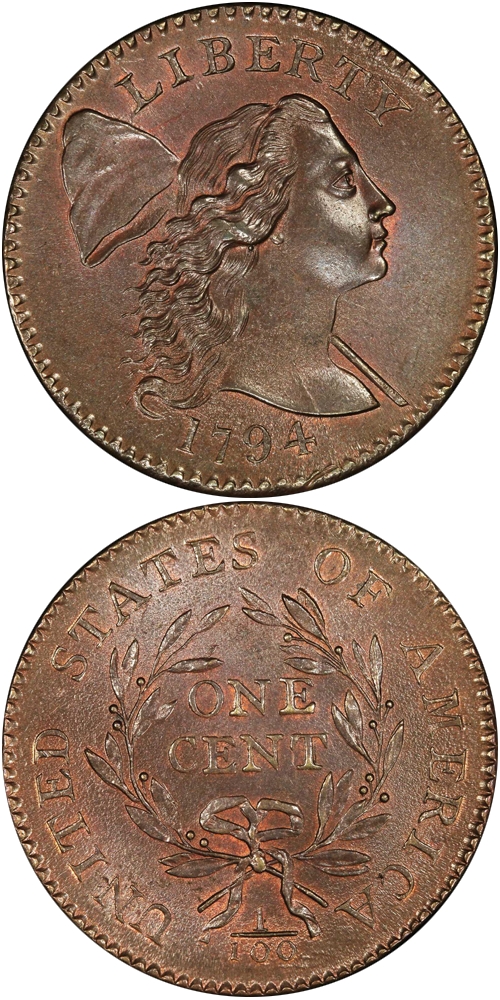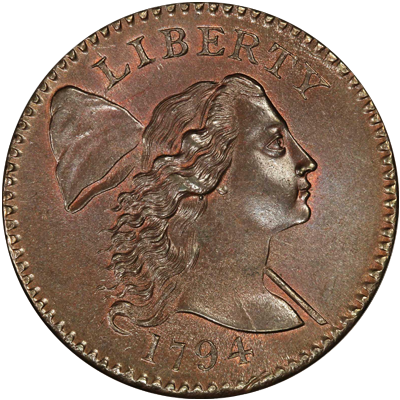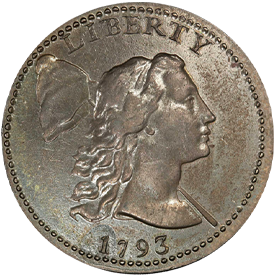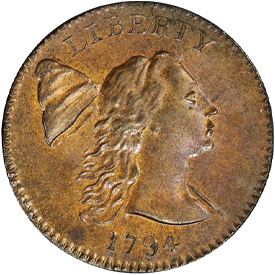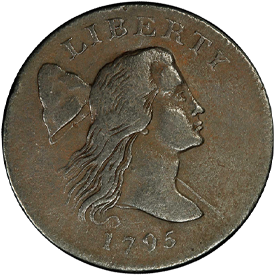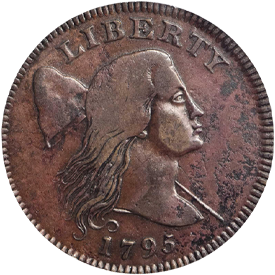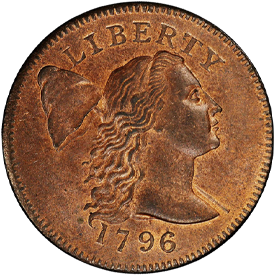Designed by: Henry Voigt
Issue Dates: 1793-1796
Composition: Copper
Diameter: Average 29 mm
Weight: 13.47 grams (208 grains, thick planchet), 10.88 grams (168 grains, thin planchet)
Edge: Early pieces lettered ONE HUNDRED FOR A DOLLAR;
the later pieces have plain edges
Business Strike Mintage: 1,577,902
Proof Mintage: None
The Liberty Cap motif made its appearance late in 1793 and was continued through 1796. The design was later (1794-1797) used on half cents. The motif features Miss Liberty facing to the right, a liberty cap on pole behind her head, LIBERTY above, and the date below. The reverse displays an open wreath enclosing ONE CENT, with UNITED STATES OF AMERICA and the fraction 1/100 surrounding. 1793 Liberty Cap cents have a beaded border, while those dated from 1794 through 1796 have denticles. The edges of 1793, 1794, and some 1795 pieces are lettered ONE HUNDRED FOR A DOLLAR, while later issues have a plain edge.
Dozens of different die varieties were produced of this motif from 1793 through 1796, with the result that there are many possibilities from which the collector can choose. The numismatist seeking simply a design type in grades from Good through Fine can select from pieces of the 1794, 1795, or 1796 dates, for 1793 Liberty Cap cents are much rarer and more expensive. In higher grades, Extremely Fine to Uncirculated, pieces dated 1795 are more readily available than those dated 1794 or 1796, with 1796 cents closely following. The sharpness of strike, planchet quality, and surface characteristics vary widely among cents of this style, so some searching may be needed to find one that is "just right.”
Further Reading
Of the three major types of 1793 cents including the Chain style and the Wreath motif, the rarest is the third – the 1793 Liberty Cap design. This issue, known in five die varieties, features superb engraving artistry. Years ago, many designated it as the French Head style, for it was similar to certain pieces issued by the Paris Mint during the period and derives its design from the Libertas Americana medal struck in France several years earlier.
The portrait features Miss Liberty facing to the right, with a liberty cap and pole behind her, LIBERTY above, and the date 1793 below. A border of raised beads at the edge contributes to the artistic effect. This same general motif appeared on the 1793 half cents, but Miss Liberty faces to the left on the smaller denomination.
The Guide Book estimates a mintage of 11,056 examples for the 1793 Liberty Cap cents, but this figure may be overly generous, for Liberty Cap cents of this year exist in limited numbers, even fewer than the suggested relative mintages indicate.
1793 Liberty Cap cents have a different "personality" as far as surface characteristics are concerned. Whereas Chain and Wreath pieces typically have porous or irregular surfaces, particularly if the pieces are in lower grades, even Good to Very Good Liberty Cap cents of 1793 are apt to have smooth medium to dark brown fields. Porosity is the exception, not the rule.
Most specimens of the 1793 Liberty Cap cent encountered are in grades from Good to Fine; however, Very Fine and Extremely Fine pieces are occasionally seen. In 1962, during a trip to England, James F. Ruddy, my business associate for many years, purchased from a noncollector a 1793 Liberty Cap cent in Uncirculated grade, or very close to it (experts have differed in their opinions). This was subsequently sold into the Charles Jay collection. Today it ranks as one of the very finest pieces known of this style.
The type set collector will find the 1793 Liberty Cap cent too expensive to illustrate the general design. Issues of 1794 and 1795, are lower-priced and more feasible for this purpose. However, there is something special about the 1793-dated coins. Perhaps it is the combination of their history, rarity, and significance as the first year of the design type.
1794 large cents, all of the Liberty Cap design, have become a collecting specialty in themselves for many numismatists. Several collectors have endeavored to acquire as many different issues as possible. The John Adams collection of 1794 cents was offered by my firm in a priced catalogue in 1982. In the same year Denis Loring, the well-known large cent student and collector, captured the Best of Show Award at the annual American Numismatic Association convention. The subject of his exhibit was 1794 large cents.
The appeal of the 1794 cent has been heightened, no doubt, by the use of fanciful names assigned to certain of the varieties. Dr. Edward Maris published in 1869 a monograph on these pieces. Using his imagination, plus his knowledge of Latin and medicine, Maris gave such names as Venus Marina, Patagonian, Double Chin, Coquette, etc. to the various issues. These names, continued by Dr. Sheldon in Penny Whimsy, are still retained by collectors and cataloguers today.
One of my personal favorites among early large cents is the singular variety of 1794 catalogued as Sheldon-48, the Starred Reverse. This coin was struck from a reverse die with 94 tiny 5-pointed stars around the periphery. These stars are indeed tiny, and a low-power magnifying glass must be used to see them clearly. The purpose of these stars is unknown. Dr. Sheldon believed that they might be the "result of the whim of an idle hour at the Mint," while Don Taxay considered them to be patterns. Whatever the explanation may be, and the true reason for the stars will probably never be known, the 1794 Starred Reverse remains one of the most curious pieces in American numismatics.
Another interesting 1794 variety is that with the so-called Office Boy Reverse (Sheldon-56). The reverse appears to be amateurishly cut, and I suppose this is the reason for the designation. Another variety is the Fallen 4, on which the final digit of the date is dropped sharply out of line with the other three numbers, simply because the engraver did not plan ahead. Still another curious 1794 cent is that with the fraction bar missing on the reverse.
The type set collector will find that 1794 cents are available in all grades from Fair through Uncirculated, with grades from Good through Fine or Very Fine being the most often encountered.
The 1795 large cents were issued in two main varieties: early specimens with lettered edges (ONE HUNDRED FOR A DOLLAR) and later specimens struck on thinner planchets with plain edges. The plain edge pieces in particular usually are weakly (if not poorly) struck and lack much design detail, a characteristic evident on pieces in high grades as well as worn issues. The student of large cents will find that issues from 1793 up through about 1795 each have their own "personalities." Die-cutting varies from issue to issue, and a half dozen different pieces are apt to have varying degrees of relief, hair detail, rim sharpness or weakness, planchet smoothness or roughness, or one of many other characteristics. After this era cents became more standard. While interesting characteristics are still to be seen, particularly in the area of die-cutting blunders and errors, most have a relatively standard appearance.
One of the most interesting 1795 varieties is the so-called Jefferson Head cent. This piece has an appearance quite unlike other 1795 cents and is generally considered to be a coin made outside of the United States Mint, possibly by John Harper, who was endeavoring at the time to secure a private contract to mint United States coins. While today we think of the United States Mint as a standard institution of the federal government, during the early years of its existence the very life of the Mint was uncertain. Several proposals in Congress called for the abolishment of the institution. Coinage by contract was considered by some to be a feasible alternative. During the 1790s several individuals and private mints sought the federal coinage business, and John Harper, a saw maker and mechanic, was one of these.
During the 1790s the famous firm of Boulton & Watt, operators of the Soho Mint in Birmingham, England, produced coins on contract for the British government and sold prepared copper planchets to the United States Mint. In 1787 James Jarvis had produced Fugio cents on contract in America for the United States government, so there was ample precedent for private coinage.
During this early period the United States Mint had tremendous problems. Mint officials had difficulty obtaining copper supplies, with administration, and with just about everything else imaginable, even including consumption of rum by employees – so it was not surprising that private parties from time to time produced convincing arguments that coinage would have fared better in private hands. Indeed, the printing of bank notes was placed in private hands decades later when the United States government first began issuing its own currency on a regular basis. Earlier notes, a part of the Continental Currency series issued during the Revolution, were likewise privately printed.
Early in 1796 additional Liberty Cap cents were produced. Several die varieties exist, all from the same obverse hub. That is, the head of Miss Liberty is standard on all, with die differences being limited to date and letter positioning.
Liberty Cap cents of 1795 and 1796 are available in all grades from Fair through Uncirculated. In the latter grade the 1795 variety Sheldon-76b occurs with regularity. Dr. Sheldon notes that "possibly 20 or so are known in Full Mint State," but I believe that number to be on the low side, for my firm alone has handled at least that many over the past 30 years. The type set collector desiring a high-grade Liberty Cap issue will probably find a 1795 to be the least costly.
